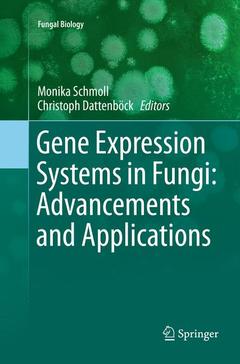Description
Gene Expression Systems in Fungi: Advancements and Applications, Softcover reprint of the original 1st ed. 2016
Fungal Biology Series
Language: English
Subject for Gene Expression Systems in Fungi: Advancements and...:
Publication date: 04-2018
Support: Print on demand
Publication date: 04-2016
499 p. · 15.5x23.5 cm · Hardback
Description
/li>Contents
/li>Biography
/li>Comment
/li>
Dr. Monika Schmoll received her degree and Ph. D. on the topic of “Regulation of cellulase expression and signal transduction in the filamentous fungus Hypocrea jecorina (Trichoderma reesei)” at the Vienna University of Technology, Austria. Besides gaining postdoctoral experience and building her own group at the Vienna University of Technology, she has been a visiting scientist in the laboratory of Professor N. Louise Glass (Department of Plant and Microbial Biology, University of California, Berkeley, USA), the University of Rome La Sapienza and the University of Szeged, Hungary. In 2012, Dr. Schmoll moved to the Austrian Institute of Technology (AIT) in Tulln, Austria, where she is now group leader and senior scientist. In march 2013 she completed her habilitation at the Vienna University of Technology in the field of “Molecular Genetics and Genomics”.
The primary research field of Dr. Schmoll is the interconnection between light response, sexual development and metabolism, with an emphasis on effects on cellulase gene expression in the filamentous fungus Trichoderma reesei. She showed for the first time that cellulase gene expression is modulated by light in T. reesei and could since then elucidate important mechanistic details on the underlying mechanism. Her group discovered the sexual cycle in the biotechnological workhorseTrichoderma, which had previously been considered asexual. Recently, her group also showed that communication upon sexual development is mediated by regulation of secondary metabolism. Her work with Trichoderma is complemented by contributions to genome annotation of several fungi (Trichoderma spp., Aspergillus nidulans, Postia placenta, Ceriporiopsis subvermispora, Phlebiopsis gigantea), especially in the field of signal transduction.
These books may interest you

Biology of Macrofungi 179.34 €



